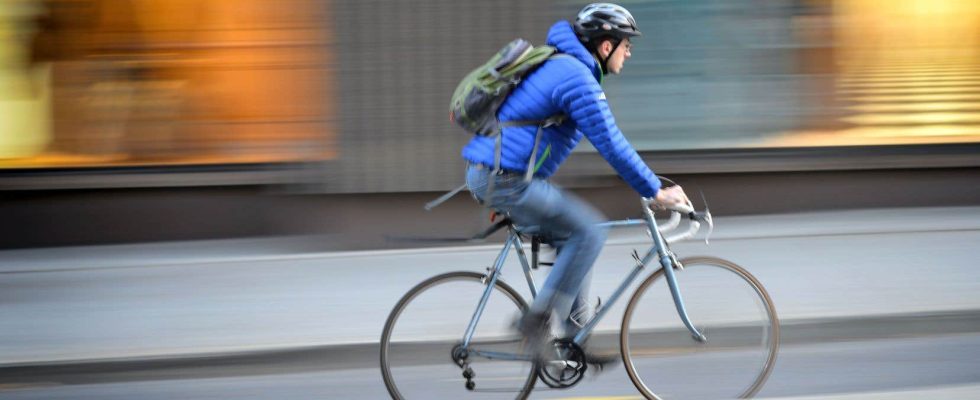Quebec, city of automobiles, takes your foot off the accelerator to better put it on the pedals. The administration of Bruno Marchand aims to “develop in a very ambitious way” the place of cycling in the capital – without giving a precise timetable for overcoming one of the major obstacles to the development of the “little queen” in the capital, namely the cliff that separates the lower town from the upper.
The City promises to offer two ski lifts to cyclists who want to reach the promontory without forcing. An “essential” measure, according to Marie-Soleil Gagné, executive director of Accès transport viable, for safety reasons first, but also to ensure the attractiveness of cycling for seniors and children.
Originally, the tram site was to create two mechanical links. The administration of Régis Labeaume had thrown them into oblivion to respect the budgetary straightjacket imposed by the government. At the time, the cost of building these two lifts was $15 million.
For the moment, the ribs that make it possible to climb and descend the cliff in a space reserved for bicycles can be counted on the fingers of one hand. The busiest, that of Pente-Douce, was not cleared of snow on Tuesday, forcing cyclists and motorists to share the road. The Faubourg elevator allows you to reach the Saint-Jean-Baptiste district, but still leaves many of the grueling pedal strokes to be given before reaching the main places of interest in Quebec.
The City presented Tuesday the programming of the 10e Month of the bike without offering a timetable for the installation of the ski lifts long awaited by the cyclists of the capital. “This is a project that we will work on over the next few years,” said Pierre-Luc Lachance, the elected official responsible for active mobility in Quebec, without further details.
Go from afar
The capital has some catching up to do with the metropolis in terms of cycling. Montreal has 901 km of bike paths, 717 km of which are accessible year-round. Of the total, 287 km offer cyclists a separate lane from car traffic. By 2027, the metropolis aims to add 200 km of new secure cycle lanes – an increase of 22% in five years. Montreal’s 2023-2027 Bike Vision plans, among other things, to build three new REVs, on boulevards Jean-Talon, Henri-Bourassa and Lacordaire, in addition to developing a bike path on Hochelaga to connect the neighborhood of the same name to Ville -Married.
By 2027, the City of Montreal is thinking big: it wants 15% of utilitarian trips to be made by bicycle in the metropolis. In 2020, the modal share of cycling in the transportation habits of Montrealers was 3.3%, according to the inventory carried out in 2020 by Vélo Québec. In the metropolis, more than 600,000 adults consider the bicycle to be a daily mode of transportation and several cycle routes account for more than one million trips per year.
In Quebec, the picture is quite different. Nine trips of less than five kilometers out of ten are still made by car. Only 1.5% of the inhabitants of the capital made their daily trips by bicycle, according to the most recent origin-destination survey carried out there, dated 2017. Finally, concludes Mme Won, from Accès transport viable, 90% of children still go to school by motorized means. “The cycling network is not always designed according to their needs,” she explains.
Change of manners
Quebec is stepping up the pace to enter “modern mobility”, as Mayor Bruno Marchand calls it. Starting this summer, a cycling corridor will see the light of day on Chemin Sainte-Foy, a busy thoroughfare linking Université Laval to downtown Paris. Eventually, Quebec plans to see some 5,000 cyclists take this section every day.
Despite the removal of a hundred parking spaces and the elimination of two traffic lanes reserved for cars, the apprehended discontent did not take place. The days when certain radio stations encouraged motorists to bar cyclists for a few centimeters of roadway seem to be more and more over in Quebec.
“It’s a societal change,” says Pierre-Luc Lachance. According to him, the population of Quebec is now wondering about the best ways to get around, and he observes that the bicycle is slowly but surely gaining support, even in a city that has long claimed its status as “capital of the chariot”.
“Attitudes have really evolved” over the past 15 years, also notes Marie-Soleil Gagné. The bicycle is slowly building its kingdom in the capital, buoyed by the enthusiasm for the shared electric bicycle service àVélo and by a municipal administration that says it is determined to “rebalance the forces” on the road.
